Biology:Vini (genus)
| Vini | |
|---|---|
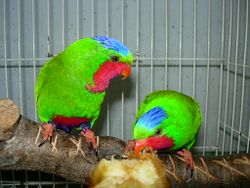
| |
| Blue-crowned lorikeet (Vini australis) | |
| Scientific classification | |
| Domain: | Eukaryota |
| Kingdom: | Animalia |
| Phylum: | Chordata |
| Class: | Aves |
| Order: | Psittaciformes |
| Family: | Psittaculidae |
| Tribe: | Loriini |
| Genus: | Vini Lesson, R, 1833 |
| Type species | |
| Psittacula kuhlii Kuhl's lorikeet Vigors, 1824
| |
Vini is a genus of birds in the family Psittaculidae that are endemic to the islands of the tropical Pacific. There are eleven extant species of these small lorikeets ranging from eastern Fiji through Samoa, French Polynesia, and as far east as Henderson Island. All members of the genus have exceptional bright plumage, particularly the unusual all over blues of the blue lorikeet and the ultramarine lorikeet.
The Vini lorikeets are highly threatened by human changes to their islands. Most species have been lost from a number of islands and two species became extinct before the arrival of European explorers in the Pacific. (As of 2017), two species are listed as endangered species by the IUCN and two are considered vulnerable.[1] They are primarily threatened by introduced species, such as rats, and habitat loss.
Taxonomy
The genus Vini was introduced in 1833 by the French naturalist René Lesson for Kuhl's lorikeet.[2][3] The genus name is the Tahitian word for a local bird.[2][4][5]
This genus formerly included only the blue-crowned, ultramarine, Stephen's, Kuhl's, and blue lorikeets (as well as the extinct Sinoto's and conquered lorikeets); the collared lory was formerly placed in the monotypic genus Phigys, and the remaining five species were placed in Charmosyna. A molecular phylogenetic study of the lorikeets published in 2020 led to a revision of the generic boundaries.[6][7][8]
Species
The genus contains 11 species:[8]
| Image | Common name | Scientific name | Distribution |
|---|---|---|---|
| Meek's lorikeet | Vini meeki | Solomon Islands | |
 |
Red-chinned lorikeet | Vini rubrigularis | Bismarck Archipelago |
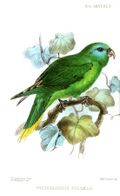 |
Palm lorikeet | Vini palmarum | Vanuatu |
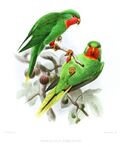 |
Red-throated lorikeet | Vini amabilis | Fiji Islands |
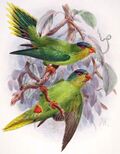 |
New Caledonian lorikeet | Vini diadema | New Caledonia |
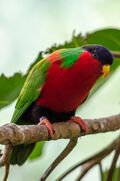 |
Collared lory | Vini solitaria | Fiji Islands |
 |
Blue-crowned lorikeet | Vini australis | Samoa, Tonga Islands and Lau Islands |
| Ultramarine lorikeet | Vini ultramarina | Marquesas Islands | |
 |
Stephen's lorikeet | Vini stepheni | Henderson Island in the Pitcairn Islands |
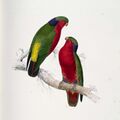 |
Kuhl's lorikeet | Vini kuhlii | French Polynesia (Tubuai and Rimatara) |
 |
Blue lorikeet | Vini peruviana | French Polynesia and the Cook Islands |
Fossils
- †Sinoto's lorikeet, Vini sinotoi (extinct)[9]
- †Conquered lorikeet, Vini vidivici (extinct)[9]
References
- ↑ "The IUCN Red Data List of Threatened Species: Vini". IUCN Red List. International Union for Conservation of Nature. http://www.iucnredlist.org/search.
- ↑ 2.0 2.1 Lesson, René P. (1833) (in French). Illustrations de zoologie, ou, Recueil de figures d'animaux peintes d'après nature. Paris: Arthus Bertrand. Plate 28 and text, livraison 10. https://www.biodiversitylibrary.org/page/28723711. For the publication date see: Dickinson, E.C.; Overstreet, L.K.; Dowsett, R.J.; Bruce, M.D. (2011). Priority! The Dating of Scientific Names in Ornithology: a Directory to the literature and its reviewers. Northampton, UK: Aves Press. p. 121. ISBN 978-0-9568611-1-5. https://www.researchgate.net/publication/267763194.
- ↑ Peters, James Lee, ed (1937). Check-List of Birds of the World. Volume 3. Cambridge, Massachusetts: Harvard University Press. p. 156. https://www.biodiversitylibrary.org/page/14477871.
- ↑ [Davies, John] (1851). "Vini". Vini. Tahiti: London Missionary Society's Press. p. 314. https://archive.org/stream/tahitianenglishd00davirich#page/314/mode/1up/. "the name of a small paroquet".
- ↑ Wahlroos, Sven (2002). "Vini". Vini. Honolulu: Māʻohi Heritage Press. p. 684. "(1) Tahiti parakeet; (2) small birds of various species imported to Tahiti".
- ↑ Smith, B.T.; Mauck, W.M.I.; Benz, B.W.; Andersen, M.J. (2020). "Uneven missing data skew phylogenomic relationships within the lories and lorikeets". Genome Biology and Evolution 12 (7): 1131-1147. doi:10.1093/gbe/evaa113.
- ↑ Joseph, L.; Merwin, J.; Smith, B.T. (2020). "Improved systematics of lorikeets reflects their evolutionary history and frames conservation priorities". Emu - Austral Ornithology 120 (3): 201-215. doi:10.1080/01584197.2020.1779596.
- ↑ 8.0 8.1 Gill, Frank; Donsker, David; Rasmussen, Pamela, eds (July 2021). "Parrots, cockatoos". IOC World Bird List Version 11.2. International Ornithologists' Union. https://www.worldbirdnames.org/bow/parrots/. Retrieved 21 July 2021.
- ↑ 9.0 9.1 Steadman, David W. (2006). Extinction and Biogeography of Tropical Pacific Birds. Chicago, IL, US: University of Chicago Press. p. 525. ISBN 978-0-226-77142-7. https://books.google.com/books?id=vBZXJQ3HDg0C&pg=PA525.
Wikidata ☰ Q508748 entry

